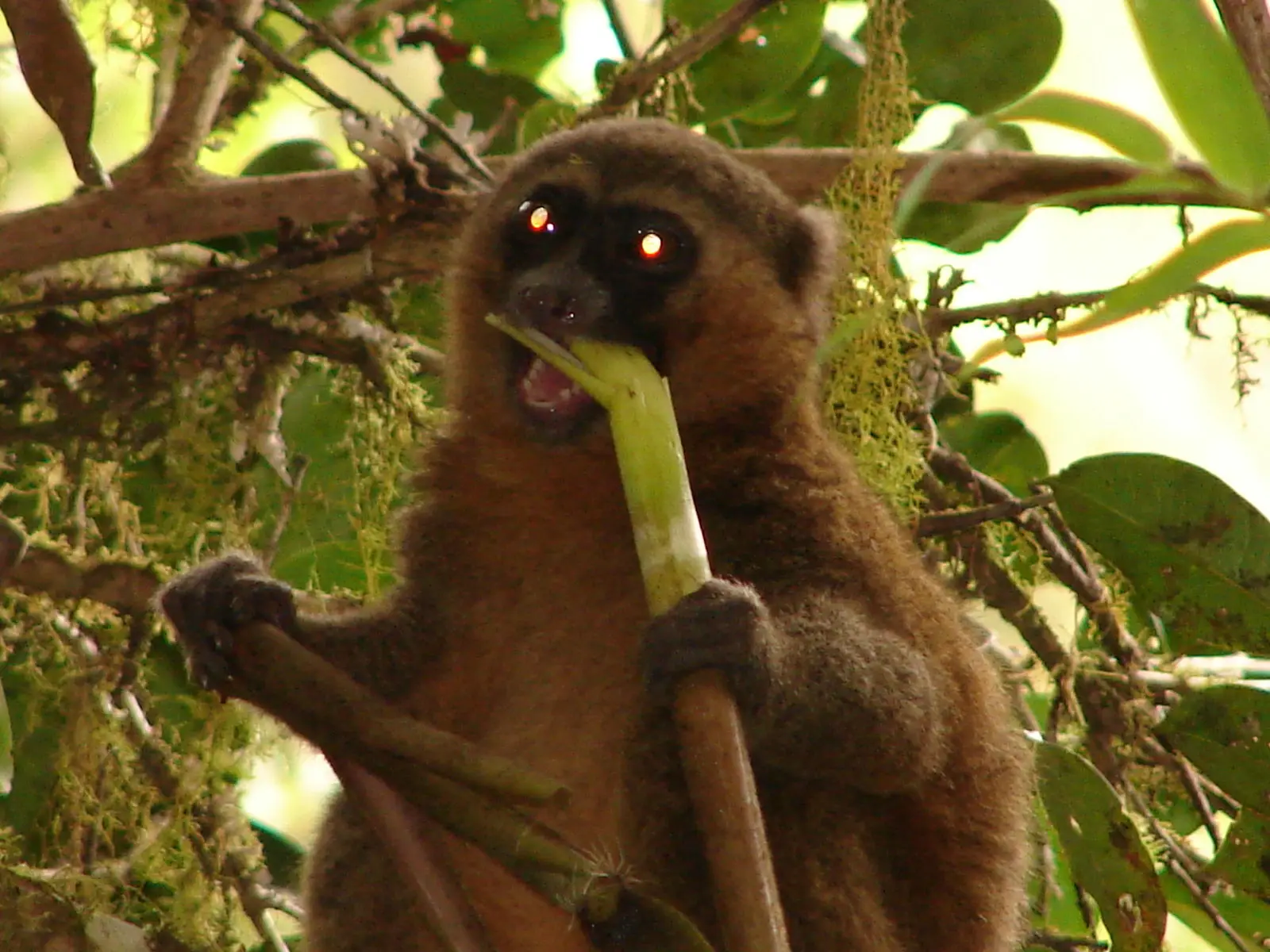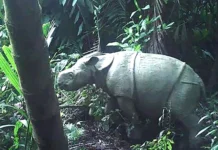The bamboo lemur, one of the many unique species found in Madagascar, is a remarkable example of the biodiversity that exists on this island. With only about 500 individuals remaining in the wild, the bamboo lemur is a critically endangered species that faces multiple threats from habitat loss, climate change, and human activity. This article explores the bamboo lemur’s characteristics, its role in the ecosystem, the conservation challenges it faces, and ongoing efforts to protect and preserve this fascinating species.

Introduction to the Bamboo Lemur
The bamboo lemur is a small, arboreal primate native to Madagascar. This lemur, known for its distinctive diet of bamboo, is one of the many lemur species that call Madagascar home. Lemurs are known for their large eyes, long tails, and often playful personalities, and the bamboo lemur is no exception. Its small size and primarily herbivorous diet make it a unique species that plays an important role in its ecosystem.
There are several different species of bamboo lemurs, each adapted to a particular type of bamboo or forest habitat. Among these, the greater bamboo lemur (Prolemur simus), is the most critically endangered, with fewer than 500 individuals remaining in the wild. This makes the greater bamboo lemur one of the rarest primates on Earth and highlights the importance of ongoing conservation efforts.
Characteristics and Habitat
Bamboo lemurs are small primates, with their size ranging between 1.5 to 2.5 kilograms (around 3.3 to 5.5 pounds). They have long, bushy tails, which help with balance as they move through the trees. Their fur is generally a reddish-brown color, providing camouflage in the dense forests of Madagascar. Their large eyes help them navigate in low-light conditions, as they are primarily crepuscular or nocturnal, being most active during dawn and dusk.
The bamboo lemur is endemic to Madagascar, meaning it is found nowhere else on Earth. This island is home to an astonishing array of unique wildlife due to its long isolation from the African mainland. The bamboo lemur thrives in the tropical rainforests of Madagascar, specifically in areas where bamboo grows. Bamboo forests, although dense and challenging to navigate, provide a primary food source for these lemurs.
Bamboo lemurs are primarily herbivores, with bamboo forming the majority of their diet. Interestingly, some species of bamboo lemurs are known to eat certain species of bamboo that are toxic to many other animals. This diet of bamboo is essential for their survival, and the loss of bamboo forests poses a significant threat to their population.
The Role of Bamboo Lemurs in the Ecosystem
Bamboo lemurs play a crucial role in maintaining the health and balance of the ecosystems in which they live. As herbivores, they help control the growth of bamboo forests by feeding on the plants. This not only influences the structure of the forest but also helps ensure that bamboo does not overgrow and choke out other plant species. Their foraging habits help maintain the biodiversity of the forest, which in turn supports other species that rely on the same habitat.
Furthermore, bamboo lemurs also contribute to seed dispersal. As they move through the forest and consume various fruits, they help distribute seeds, encouraging the growth of different plant species. This act of seed dispersal is essential for maintaining the forest’s overall ecological balance and facilitating regeneration in the forest.
Conservation Challenges Facing the Bamboo Lemur
Despite the bamboo lemur’s important ecological role, the species faces numerous challenges that threaten its survival. The population of bamboo lemurs, especially the greater bamboo lemur, has drastically declined in recent decades due to various factors, most notably habitat destruction.
Habitat Destruction
One of the main threats to the bamboo lemur is habitat destruction. Madagascar’s forests, including the bamboo forests that these lemurs rely on, have been rapidly declining due to logging, agriculture, and slash-and-burn farming practices. As forests are cleared for farming and other human activities, the bamboo lemurs are losing their homes. Bamboo lemurs require dense bamboo forests with a certain structure and composition of vegetation to thrive, and the loss of this habitat makes survival increasingly difficult for them.
Human Activity and Agriculture
The expanding human population in Madagascar has led to increased demand for agricultural land, particularly for the cultivation of crops such as rice and cassava. In many cases, this has resulted in the conversion of forests into farmlands, which not only reduces the area where bamboo lemurs can live but also reduces the availability of food sources. Additionally, the use of fire to clear land often destroys the bamboo forests that are essential to the lemurs’ diet.
Climate Change
Climate change is another growing concern for the bamboo lemur population. Changes in temperature and rainfall patterns can affect the growth and distribution of bamboo, potentially disrupting the food supply for these lemurs. As bamboo species become less abundant or harder to access due to changing environmental conditions, bamboo lemurs may struggle to find sufficient food. Furthermore, changing climates could alter the structure of their habitat, making it less suitable for the lemurs.
Illegal Hunting and Trade
While the primary threat to the bamboo lemur comes from habitat loss, illegal hunting and the wildlife trade are also significant risks. Though not as common as other threats, the illegal pet trade and hunting for bushmeat have still contributed to the decline of some lemur populations. Poaching activities, although less widespread than habitat destruction, are a concern for certain lemur species in Madagascar, including the bamboo lemur.
Conservation Efforts to Save the Bamboo Lemur
In recent years, there have been substantial efforts to conserve the bamboo lemur, primarily focused on habitat protection and restoration. Several key organizations and conservation groups are working to safeguard the remaining bamboo lemur populations and provide them with a sustainable future.
Habitat Protection and Forest Restoration
One of the central strategies for conserving the bamboo lemur is protecting and restoring its natural habitat. Several conservation programs focus on creating protected areas in Madagascar where bamboo lemurs can live safely. This includes the establishment of national parks and wildlife reserves in key regions, such as the Ankeniheny-Zahamena Corridor, which is home to a significant population of greater bamboo lemurs.
These protected areas help reduce the threat of habitat destruction and provide a safe haven for lemur populations to thrive. Conservationists also focus on reforesting degraded areas by planting bamboo and other indigenous plants to restore the lemurs’ natural environment. This restoration work is critical for the long-term survival of the species.
Sustainable Farming and Community Engagement
Another important aspect of bamboo lemur conservation is working with local communities to develop sustainable farming practices that do not require the destruction of forests. By promoting alternative livelihoods and agricultural techniques, such as agroforestry, conservationists aim to reduce human pressure on the bamboo lemur’s habitat. Community engagement is crucial in these efforts, as local populations often have a deep connection to the land and can play an active role in protecting their environment.
Ecotourism and Awareness Campaigns
Ecotourism has become an increasingly popular way to raise funds for conservation efforts while providing locals with alternative sources of income. By creating eco-friendly tourism opportunities, conservation programs can generate revenue that helps fund habitat protection and restoration projects. Tourists visiting Madagascar are often interested in the opportunity to see the bamboo lemur in its natural habitat, and ecotourism offers an educational platform for raising awareness about the species’ plight.
Public awareness campaigns are also key to ensuring long-term conservation success. Educating both the local Malagasy population and the global community about the importance of preserving Madagascar’s unique biodiversity can help garner support for conservation initiatives and ensure sustainable practices are adopted.
The Future of the Bamboo Lemur
Despite the challenges, there is hope for the bamboo lemur’s future. Conservation efforts in Madagascar have led to some positive outcomes, including population stabilization and the establishment of new protected areas. With the continued support of conservation organizations, governments, and local communities, the bamboo lemur can have a fighting chance at survival.
However, the species remains critically endangered, and much work is still needed to ensure its long-term survival. The future of the bamboo lemur will depend on ongoing efforts to protect its habitat, promote sustainable practices, and combat the threats of climate change and human encroachment.
Conclusion
The bamboo lemur is a symbol of the extraordinary biodiversity found in Madagascar and a reminder of the fragile nature of our planet’s ecosystems. With only around 500 individuals remaining, it faces numerous threats, but the efforts to conserve and protect it are ongoing. Through habitat protection, sustainable farming practices, and community engagement, there is hope for the bamboo lemur to continue to thrive in the wild for generations to come.
By understanding the importance of the bamboo lemur and supporting conservation efforts, we can contribute to the preservation of this remarkable species and the ecosystems it inhabits. The story of the bamboo lemur is one of both struggle and hope, and it highlights the importance of conservation for the future of our planet’s endangered wildlife.





























